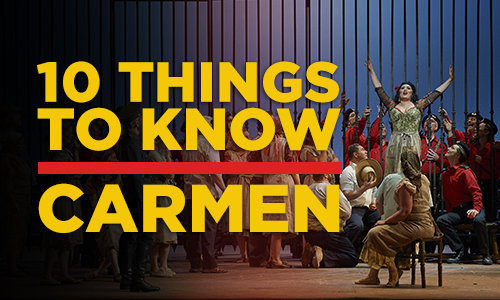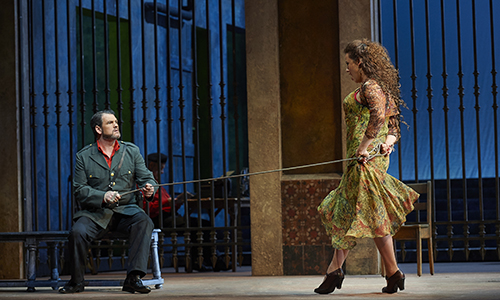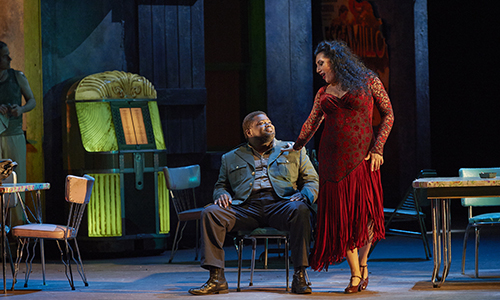-
10 Things to Know: Carmen
By COC StaffPosted in Carmen
1) Initially a disaster…
Carmen was first performed in 1875 at the Opéra-Comique theatre in Paris, a venue known primarily for family-friendly entertainment. Bizet’s opera, however, was a dramatic departure from that kind of theatre: it featured overtly sexual themes and imagery, morally ambiguous characters, a story that ends with murder, and a female protagonist who proudly defies the social norms and moral codes of her times in favour of a spirited (and, to many of the conservative-minded patrons in the audience, morally suspect) commitment to self-determination. The opera’s content sparked outrage and harsh criticism among the press; the theatre even resorted to giving tickets away for free just to fill the house. Bizet died within three months of the failed premiere, at only 36 years old.
2) ...today’s (second) most popular opera
According to Operabase, an online repository for opera performance information and statistics, only Verdi’s La Traviata is staged more often than Carmen in today’s opera houses. It has been adapted and reinterpreted in various forms, including some 10 film versions, a Broadway musical (Carmen Jones), a TV-movie in the early 2000s starring Beyoncé (Carmen: A Hip Hopera), and even an ice-dancing show. Queen Victoria, James Joyce, Otto von Bismarck, and Friedrich Nietzsche all considered Carmen their favourite opera, and it features in novels by Thomas Mann and Vladimir Nabokov. Its music has been thoroughly absorbed by popular culture, frequently sampled in ads, movies, TV shows, and cartoons.
"Your Carmen is a flop, a disaster! It will never play more than 20 times. The music goes on and on. It never stops. There’s not even time to applaud. That’s not music! And your play—that’s not a play! A man meets a woman. He finds her pretty. That’s the first act. He loves her, she loves him. That’s the second act. She doesn’t love him anymore. That’s the third act. He kills her. That’s the fourth! And you call that a play? It’s a crime, do you hear me, a crime!"
—One of the many negative reactions that initially greeted Carmen, this one from Jean-Henri Dupin’s letter to his friend and Carmen librettist Henri Meilhac, delivered the morning after the premiere.
3) The story at a glance
Carmen is a seductive, freedom-loving woman, desired by many. She takes Don José, a young soldier, as her latest lover, who defects from the army to join her in her smuggling life. But when she loses interest and begins a relationship with the exciting toreador Escamillo, Don José cannot accept her rejection. Their final encounter, outside the bull ring, ends tragically when Don José stabs her to death.

4) The music
In terms of its form, Bizet’s opera is a fairly conventional example of the opéra comique genre, structured around arias, duets, ensembles, and spoken dialogue (unlike its contemporary counterpart grand opera, opéra comique was unique for including spoken—rather than sung—speech). Though Bizet adhered closely to structural conventions, his prodigious talents as a melody-maker are on display throughout the score, giving us some of music history’s greatest hits. Moreover, in Carmen, according to musicologists Carolyn Abbate and Roger Parker, we witness “Bizet’s greatest gift [which was] to imagine the music for every element of the plot with equal seriousness: the trivial, ornamental characters, the tragic proletarian soldier, the smugglers singing in close harmony, the swaggering exhibitionist, the generic supporting roles; he pays close attention to each and every one.”*
5) Exoticism
Bizet’s opera is, to a certain extent, an example of 19th-century European Exoticism, an artistic trend which depicted—in often highly problematic, patronizing ways—the people and places of “the East,” be it Asia, North Africa, the Middle East or, as in the case of Carmen, the “exotic” gypsy population of Spain. In Bizet’s rendition, the Spanish setting is at once bright and colourful, full of vitalizing energy, but also dangerous, violent, and gritty

6) Stage-within-a-stage
Carmen is unique in that so much of its music occurs within the drama as musical performance, as opposed to the naturalized forms of emotional reflection or soliloquy we might be used to in opera. For example, when Carmen sings and dances the Habañera in Act I, she is actually singing and dancing for the entertainment of the characters on stage. Escamillo, the dashing toreador, performs his triumphant song for the onlookers at the city square in the same vein, with his singing recognized as a musical performance by the logic of the opera.
7) An updated revival
This COC production of Carmen is being updated by Toronto director Joel Ivany, artistic head of the indie theatre company, Against the Grain Theatre, known for unconventional stagings, including productions in a bar (La Bohème), a university attic space (The Turn of the Screw), a wedding venue (The Marriage of Figaro), and—coming up this May—a CBC TV studio (A Little Too Cozy). With Carmen, Ivany’s approach focuses on the highly relatable characters and dramatic situations of the opera. He also expands the performance space into the entirety of the auditorium—as opposed to only the stage—to create a heightened sense of immersion and proximity to the drama for the audience.

8) The setting
This production of Carmen transports the story to 1940s Latin America, utilizing a vibrant background and gritty atmosphere ideal for the opera’s storyline. The main set features a small-town square in Act I, with crumbling plastered walls painted with graffiti and covered with peeling posters. Act II sets the scene at an outdoor tavern. It’s shabby but there is no shortage of drinking and dancing, enlivened by the presence of the band of smugglers. The smugglers in Act III loiter in the ruins of a church in the mountains, and the Act IV finale takes place in a more unglamorous part of the bullfight arena, in the hallways under the seats.
9) The costumes
The costumes, by François St-Aubin, are colourful and range from the simple dresses of the cigar factory workers in Act I to the party wardrobe of those attending the bullfight in the final act. Escamillo, the narcissistic bullfighter, is outfitted like a rockstar of the era, and the women in his entourage channel—or attempt to channel—Hollywood glamour. The men of the town wear traditional wide-legged pants and summer shirts. The factory workers combine peasant tops, with scoop necklines and short sleeves, with multi-coloured skirts and wedge shoes. Micaëla stands out from the group. As a young and innocent woman from a rural village, she wears more traditional and modest clothes with a shawl over her head.
10) Two of the world’s best Carmens
Anita Rachvelishvili
(April 12, 17, 23, 30, May 4, 6, 13, 2016)Clémentine Margaine
(April 20, 28, May 8, 10, 12, 15, 2016)

● Has performed Carmen at the world’s leading opera houses including La Scala, the Metropolitan Opera, San Francisco, and Berlin
● “With her smoldering, earthy sexuality she is ideal for the role, managing to seem untamed, almost unhinged at times, yet also coolly calculating.” (New York Times)
● Makes her COC debut and is slated to perform Carmen in the near future with the Metropolitan Opera, Lyric Opera of Chicago, and the Opera Bastille in Paris
● “Margaine’s voice is rich along its entire spectrum, from a searing top to a sultry lower register, with a middle that can be fiery and smoldering or silken, tender and warm.” (Opera News)
Carmen is on stage at the Four Seasons Centre from April 12 - May 15, 2016. To buy tickets, visit coc.ca/tickets
*Abbate, Carolyn and Roger Parker. A History of Opera: The Last 400 Years. London: Penguin Books, 2012
Photo Credits (top - bottom): Anita Rachvelishvili as Carmen in Carmen (COC, 2016), photo: Michael Cooper; Clémentine Margaine as Carmen and David Pomeroy as Don José in Carmen (COC, 2016), photo: Michael Cooper; Russell Thomas as Don José and Anita Rachvelishvili as Carmen in Carmen (COC, 2016), photo: Michael Cooper; A scene from Carmen (COC, 2016), photo: Gary Beechey.
